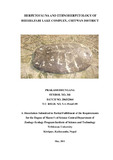Please use this identifier to cite or link to this item:
https://elibrary.tucl.edu.np/handle/123456789/3562| Title: | Herpetofauna and Ethnoherpetology of Beeshazari Lake Complex, Chitwan District |
| Authors: | Dhungana, Prakash |
| Keywords: | Wetlands;Wildlife conservation |
| Issue Date: | 2011 |
| Publisher: | Central Department of Zoology |
| Institute Name: | Central Department of Zoology |
| Level: | Masters |
| Abstract: | The study was conducted in the Beeshazari lake complex and its surrounding settlements. The lake lies in Buffer Zone of Chitwan National park (CNP). The study was conducted from June 2008 to December 2009. The study basically aimed at enumerating the diversity of herpetofauna, ethnoherpetology and conservation threats. Beeshazari Lake covers an area of 180 hectare (BPP, 1995). There are 242 recorded wetlands in Nepal. However, herpetofauna of these wetlands are not well known so far. The herpetofauna of the Nepal is extremely rich. The herpetofauna are distributed a wide altitudinal range from 80m to 5490m. Though only a little information is known about their status and distribution in the country. Beeshazari Lake is one of the important wetlands of Nepal. Altogether 32 species of herpetofauna were recorded from Beeshazari lake complex. Among them 9 species of Amphibians belonging to 3 families and 5 genera and 23 species of Reptiles (including 7 species of lizards, 1 species of crocodile, 10 species of snakes and 5 species of turtles) belonging to 13 families and 19 genera were recorded from the study area. Among the recorded species of herpetofauna, 2 species are fully protected by the Government of Nepal, National Park and Wildlife Conservation Act, 1973, 10 species are listed in different Appendices of CITES categories, 9 species are included in different threat categories of IUCN Red Data Book and 12 species are listed in National Red Data Book. Some of the herpetofauna species recorded from the Beeshazari lake complex are used for both food and medicinal value. Common bull frog, monitor lizard, Crocodile, python and almost all species of turtles are used for food and medicinal value by local inhabitants of the study area. Varanus species and turtles species are highly exploited for food and medicinal purposes in that area. Habitat loss, water pollution, forest fire, over grazing, deforestation, collection of eggs, natural predator, disturbances by the local people, wanton killing, and leaching of the inorganic fertilizers and pesticides from farmland are found to be the major threats to the survival of the herpetofauna species in Beeshazari lake complex. Equally important in this context is the problem of conservation. In order to increase the population of the herpetofauna in the study area management scheme has to be applied. For this purpose killing of herpetofauna species, their products and also fishing should be strictly prohibited. Awareness for the conservation of herpetofauna species should also be augmented among the people. Human disturbances should be addressed for long term conservation of threatened species of herpetofauna. |
| URI: | http://elibrary.tucl.edu.np/handle/123456789/3562 |
| Appears in Collections: | Zoology |
Files in This Item:
| File | Description | Size | Format | |
|---|---|---|---|---|
| Cover.pdf | 273.63 kB | Adobe PDF |  View/Open | |
| Chapter.pdf | 707.07 kB | Adobe PDF |  View/Open |
Items in DSpace are protected by copyright, with all rights reserved, unless otherwise indicated.
